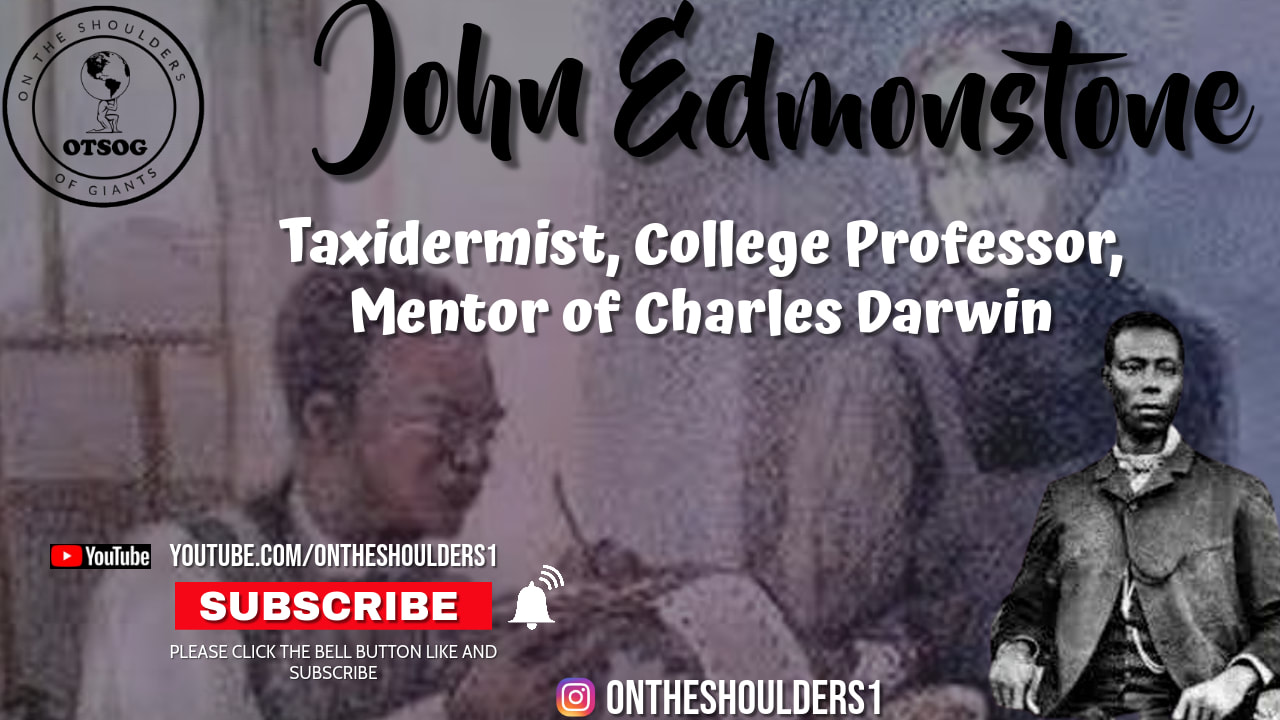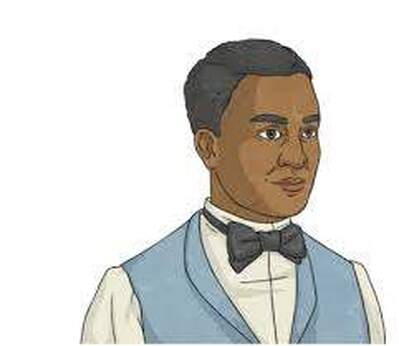|
John Edmonstone was a black man who used his knowledge to directly affect scientists who had a huge influence on the western world. Little is known about him as a man or his personal life, but we do have information about his professional life. Professionally, he was able to leave a legacy most former slaves wouldn’t imagine. A Scottish politician named Charles Edmonstone owned a plantation in Demerara, Guyana, the plantation that was said to be John Edmonstone’s place of birth. While living on the plantation, John Edmonstone befriended Charles Edmonstone’s son-in-law Charles Waterton. The two shared a love of nature; Carles Waterton was knowledgeable about the plants and animals of the rain forest. He used his knowledge to capture and expertly preserve the bodies of various birds. Because of the humid conditions of the rain forest, Charles Waterton quickly prepared and beautifully preserved the birds he captured. John Edmonstone was intrigued and spent as much time as he could learning about the Amazon Rain Forest and an expert form of taxidermy. John Edmonstone received a first-hand education about the plants and animals of Guyana, he also gained an understanding of the science of biology that would help him later in life. Around the year 1817, Charles and John Edmonstone traveled to Scottland after the passing of the 1807 Slave Trade Act, an act that banned slavery throughout the United Kingdom. John Edmonstone was able to take advantage of the passing of The Slave Trade Act and gained his freedom. Shortly after becoming a free man, John moved to Edinburgh, Scotland finding a residence close to the University of Edinburgh at 37 Lothian Street. He began working at a local museum as a Taxidermist, he also began teaching the art of Taxidermy at the University of Edinburgh. John was a successful teacher and Taxidermist. He was known for preserving various animals from across the world. He preserved a fifteen foot-long Boa Constrictor that gained a lot of attention from his peers and students. John Edmonstone is widely known within the world of biology and taxidermy as the mentor of Charles Darwin. Darwin began learning from John Edmonstone at the age of seventeen, he eventually hired John to teach him taxidermy paying him the equivalent of one hundred and sixty dollars a week. John had an enormous influence on Darwin, even influencing his professional decision to become a naturalist, geologist, and biologist. Unfortunately, we don’t know much about the birth or the death of John Edmonstone, the majority of what we do know about him comes from Darwin’s memoirs. But from the information we have, we can see how brilliant and iconic John was. He was fortunate enough to be able to learn as a slave, he was able to earn his freedom via traveling to Scotland where slavery was abolished. He then used the information he learned about biology and taxidermy to earn a living as a University professor and Taxidermist at the local museum. Stories like these need to be told so we can see the continuous perseverance of our ancestors, as well as, how they were able to influence the industries that would shape the western world. Mr. John Edmonstone, we stand on your shoulders. J.A. Ward Click here to learn more about the On the Shoulders of Giants book series!!! References:
https://www.atlasobscura.com/articles/freed-slave-darwin-taxidermy https://biodiversity.utexas.edu/news/entry/john-edmonstone https://www.history.co.uk/shows/not-what-you-thought-you-knew/articles/john-edmonstone-%E2%80%93-the-man-who-taught-darwin https://www.lindahall.org/john-edmonstone/
2 Comments
On April 27, 1945, Frederick August Kettel, Jr. was born in Pittsburgh, Pennsylvania to parents Frederick August Kettel, Sr. and Daisy Wilson. His father was a German immigrant who worked as a baker, his mother was a black woman from North Carolina who was a domestic worker. August was the fourth of six children who were raised mainly by their mother in the Hill District of Pittsburgh. In the late 1950s, Daisy Wilson remarried a man named David Bedford, the family then moved from the predominantly black Hill District to the predominantly white Hazelwood neighborhood. Being biracial in the Jim Crow era was difficult for August, he was often harassed in his neighborhood and at school because of his complexion, finding a space where he felt he belonged did prove to be difficult. 1959 was also August’s first year of high school. He was one of fourteen black children attending Central Catholic High School, unfortunately, he faced racist acts so often it drove him to drop out of school. He later enrolled in Connelley Vocational High School but again dropped out because he wasn’t learning anything. August had a thirst for knowledge but the educational institutions he attended were not adequate to intellectually stimulate him. He gave receiving a formal education one last try before dropping out again after he was accused of plagiarizing a paper he wrote about France’s Napoleon I. His teacher was not smart enough to realize she had a literary genius in her presence. August Wilson was a sixteen-year-old who was determined to learn, the Carnegie Library of Pittsburgh and the streets of Pittsburgh became his classroom, while finding any job he could to make a living. Every opportunity he had to learn something new he took full advantage of it, consuming book after book, setting the stage for one of the greatest literary careers in history. In 1962, August enlisted into the US Army after a disagreement with his mother over his career choice, he made his mind up that he wanted to be a writer. After spending only one year in the Army he returned home to pursue his goal of becoming a writer. He once again worked menial labor jobs to provide for himself, he also changed his name from Frederick August Kittel, Jr., to August Wilson, using the last name Wilson to honor of his mother. August was able to buy a typewriter after earning enough money, which officially began his career as a writer. He immediately began writing material that would become the foundation of some of the greatest American literature. Influenced by the culture surrounding him, August wrote as if his life was on the line. He wrote everywhere he went. Bars, lounges, cafes, any place he could find a napkin to write on, he would write what was on his mind. He didn't mind using napkins to write on, he was dedicated to writing and capturing his thoughts as they came to him. He started submitting his writings to Harper’s Magazine and other outlets because he wanted to expose the world to his work. Over time, he learned to become comfortable expressing his blackness and his love for his blackness through his writings. His life and writings were influenced by Malcolm X, Elijah Muhammad, and other black leaders of the time. Black Power was a concept that was prevalent in August's mind. In 1968, The Black Horizon Theater was founded by Penny Hill, Curtiss Porter, Tony Fountain, E. Phillip McKain, and August Wilson. The Black Horizon Theater was a black nationalist theater company created to inspire black art, black creativity, and black political activism. In 1973, August's first play was titled Recycle, which was performed for fifty cents a ticket. In 1977, he wrote the plays Black Bart and the Sacred Hills, before moving to St. Paul, Minnesota in 1978. After arriving in St. Paul, he began writing educational scripts for the Science Museum of Minnesota, only to quit after receiving a fellowship for The Playwrights' Center. August was laser-focused on becoming an accomplished writer and nothing was going to stop him. He became associated with a black theater company in Minnesota by the name of the Penumbra Theatre Company of St. Paul, the theater company helped him produce and feature a number of his plays. August would go on the write the plays Fullerton Street, Jitney, Ma Rainey's Black Bottom, Joe Turner's Come and Gone, and Fences, he also was awarded the New York Drama Critics' Circle Award for Best American Play Ma Rainey's Black Bottom, the Whiting Award for Drama, the Pulitzer Prize for Drama, the Tony Award for Best Play, and the Outer Critics Circle Award for his play Fences, and he was also named Artist of the Year by the Chicago Tribune, all of these accomplishments by the end of 1987. Later in 1987, the St. Paul Mayor named May 27th, August Wilson Day. August moved to Seattle, Washington in 1990, which became the location for his “Century Cycle” or the “Pittsburgh Cycle”, his cycle of ten plays that were set in Pittsburgh, with the help of the Seattle Repertory Theater, the theater also helped to produce his one-man show titled How I Learned What I Learned. After 1987, August produced nine more plays; Fences, The Piano Lesson, Ma Rainey's Black Bottom, and Joe Turner's Come and Gone, are his most accomplished and popular plays. August earned 28 honors and awards for his phenomenal work, his ten-play cycle was legendary and placed him in rare air as a writer and creator. August Wilson died in 2005 due to liver cancer at the age of sixty. After his death, he was honored when the name of one of New York City’s theaters in the Broadway Theater District was renamed the August Wilson Theater. This is the story of a man who wrote his place into history. Frederick August Kettel, Jr., aka, August Wilson, we proudly stand on your shoulders. J. A. Ward. Click here to get your copies of the On the Shoulders of Giants book series!! References: https://americantheatrewing.org/legends/august-wilson/ https://en.wikipedia.org/wiki/Black_Horizon_Theater https://www.neh.gov/about/awards/national-humanities-medals/august-wilson https://www.pbs.org/wnet/americanmasters/august-wilson-the-ground-on-which-i-stand-august-wilsonbiography-and-career-timeline/3683/ https://www.centertheatregroup.org/programs/students/learn-about-theatre/august-wilson-monologue-competition/august-wilson-biography/ https://en.wikipedia.org/wiki/August_Wilson https://www.britannica.com/biography/August-Wilson |
Details
Categories
All
Click Here to join our mailing list
|
Contact Us: |
Connect With Us |
Site powered by PIT Web Design





 RSS Feed
RSS Feed



